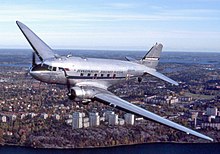 A DC-3 similar to the one involved in the crash | |
| Occurrence | |
|---|---|
| Date | 7 December 1949 |
| Summary | Controlled flight into terrain; Undetermined |
| Site | 5 miles north of Benicia, California [1] 38°7′32.0″N122°8′51.1″W / 38.125556°N 122.147528°W |
| Aircraft | |
| Aircraft type | Douglas DC-3 |
| Operator | Arrow Air |
| Registration | N60256 |
| Flight origin | Burbank, California [2] |
| Stopover | Oakland, California |
| Destination | Sacramento, California |
| Occupants | 9 |
| Passengers | 6 |
| Crew | 3 |
| Fatalities | 9 |
| Survivors | 0 |
The 1949 Arrow Air DC-3 crash was an aviation accident that occurred on December 7, 1949, near Benicia, California. The aircraft, a Douglas DC-3 operated by Arrow Air, was flying from Oakland, California to Sacramento with 9 occupants, when it crashed. The cause of the crash was never confirmed, but evidence pointed towards pilot error. Everyone on board were killed in the crash.